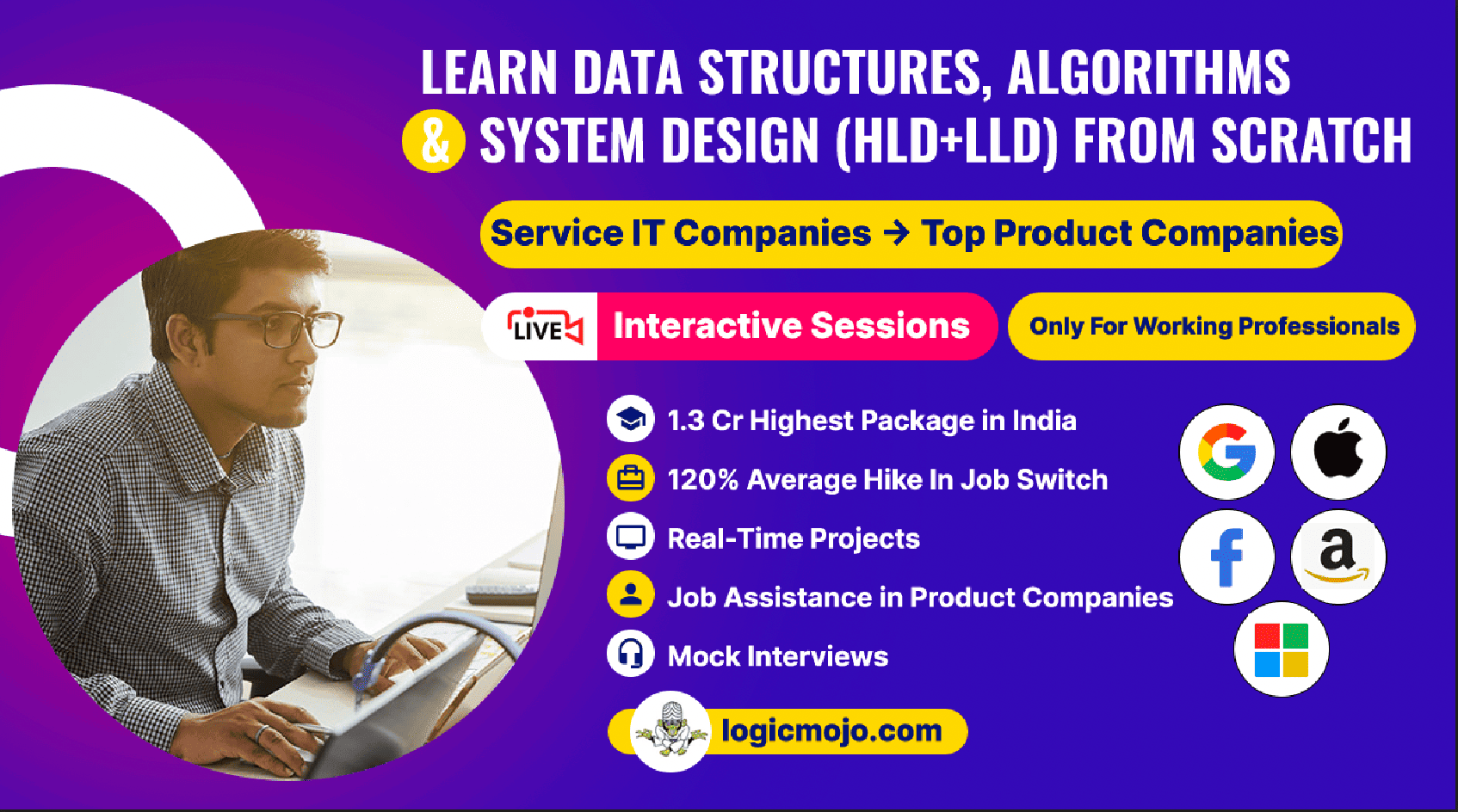What are the Types of Operating System?
Multithreading means multiple threads and is considered one of the most important features of Java. As the name suggests,
it is the ability of a CPU to execute multiple threads independently at the same time but share the process resources simultaneously.
Its main purpose is to provide simultaneous execution of multiple threads to utilize the CPU time as much as possible.
It is a Java feature where one can subdivide the specific program into two or more threads to make the execution of the program fast and easy.
All of the essential duties, such as managing files, processes, and memory, are handled by an operating system.
As a result, the operating system serves as the resource manager for all resources & serves as a conduit between the user and the computer.
Types of Operating System:
There are currently numerous varieties of operating systems. We'll talk about different Types of Operating System kinds' advantages and disadvantages in this section.
Batch Operating System
Time-Sharing Operating Systems
Distributed Operating System
Embedded Operating System
Real-time Operating System
Multiprogramming Operating System
Multiprocessing Operating System
Network Operating System
💡 Must Check Functions of Operating System
Batch Operating System
A batch operating system collects and processes all programs and data in batch form. Reducing setup time and sending related activities to the CPU are
the major goals of using a batch processing system. Both the card readers and the hard drive used batch processing techniques.
Similar jobs are grouped together into batches in a Batch Operating System with the help of an operator, and these batches are completed one by one.
Let's pretend we have ten programmes that need to be run. Some applications are written in C++, while some are written in C and the rest in Java.
Now, every time we run one of these programmes separately, we must first load the compiler for that language and then execute the code.
But what if we put together a package of these ten shows?
The below image shows how a batch operating system works. A batch operating system processes jobs one at a time, in batches. Jobs are submitted to the batch
operating system by users on punch cards. The batch operating system then sorts the jobs into batches based on their requirements. Each batch is then processed
one at a time, with the CPU assigned to the job in the batch that is ready to run.
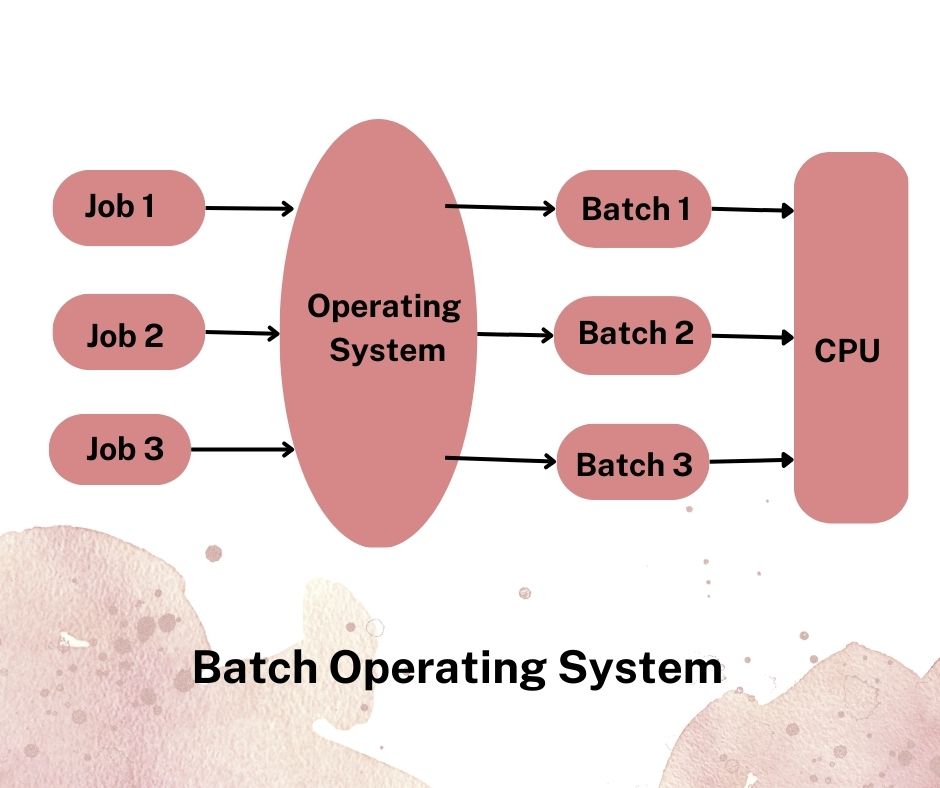
Examples of Batch Operating Systems:
Payroll system, Bank statements, Data entry, etc.
Advantages of Batch Operating System :
It's impossible to foresee or estimate how long a project will take to complete.
When a work is queued, batch system processors know how long it will take.
Batch systems can be used by multiple people at the same time.
There is very little downtime with the batch system.
Batch processing systems can be used by small organizations to gain from the execution of tiny jobs.
The batch jobs can be set to run at a specified time, so that the machine will begin processing them when it is idle.
Your batch system can operate in offline mode, giving the system's processors a well-earned break.
It is straightforward to manage vast volumes of work repeatedly in batch systems.
Disadvantages of Batch Operating System :
The computer operators should be experienced with batch systems.
Batch systems are complex to troubleshoot.
Batch systems require training for computer operators.
The debugging of batch systems is challenging.
Batch systems might be expensive at times.
Other jobs will have to wait an undetermined amount of time if a particular job takes too long, for example, if there is a mistake in the job.
If one of the jobs fails, the others will be forced to wait an undetermined amount of time.
Time-Sharing Operating Systems
A time-sharing operating system allows multiple users to use a single computer system simultaneously, each at a separate terminal or shell.
Time sharing refers to the sharing of processor time (CPU) across several users.
Multiple processes are run at the same time in a Multi-tasking Operating System using the time-sharing principle.
So, in a time-sharing environment, we set a time limit, which we call a time quantum, and when a process starts, it runs for exactly that amount of time,
after which other processes get a chance to run for that amount of time.
The first process will appear for execution in the next cycle, and it will only run for that time quantum before the second process appears.
This course of action will be followed. To ensure that everything works smoothly, each task is assigned a specific amount of time to perform.
Each user gets CPU time because they share a single system. Time-Sharing Operating Systems are also known as multitasking systems.
A single user or a group of people may initiate the task. The amount of time it takes to accomplish each task is referred to as quantum.
The below image shows how a time-sharing operating system works. A time-sharing operating system allows multiple users to access and use the same computer at the same
time. The operating system does this by dividing the computer's resources among the users and giving each user a small amount of time to use the resources.

Examples of Time-Sharing Operating Systems:
Windows 2000 server, Windows NT server, Unix, Linux etc.
Advantages of Time-Sharing Operating Systems :
Each process is given the same amount of time, each process has an equal chance to run.
Most of the time, the CPU will be busy, which is a good thing.
There are fewer chances of program duplication, and CPU idle time can be reduced.
Disadvantages of Time-Sharing Operating Systems:
The issue of reliability
It is necessary to protect the security and integrity of user programs and data.
Communication issue with data
Each process is given equal opportunity, processes with higher priority will not get the chance to be executed first.
Distributed Operating System
In distributed systems, several users and multiple real-time applications are served by multiple central processors. The processors are assigned tasks
based on how much data has to be processed.
These operating systems are a relatively new development in the field of computer technology, and they are swiftly gaining traction around the globe.
A group of independent networked computers communicates with one another via a shared communication network. Each system is self-contained, with its own
memory and processor. These types of systems are referred to as loosely coupled systems or dispersed systems.
These systems' processors come in a variety of sizes and functions. The fundamental benefit of adopting these operating systems is that a user may
always access files or apps that are not physically present on his system but are on another system connected to the network, i.e. remote access is
enabled within the connected devices.
As in the below image, we have multiple systems in a Distributed Operating System, and each of these systems has its own CPU, main memory, secondary memory, and resources.
These systems communicate with one another using a shared communication network. Each system may do its duty on its own in this environment.
The best feature of these Distributed Operating Systems is remote access, which allows one user to view data from another system and work with it.
Remote access is thus available in these distributed Operating Systems.
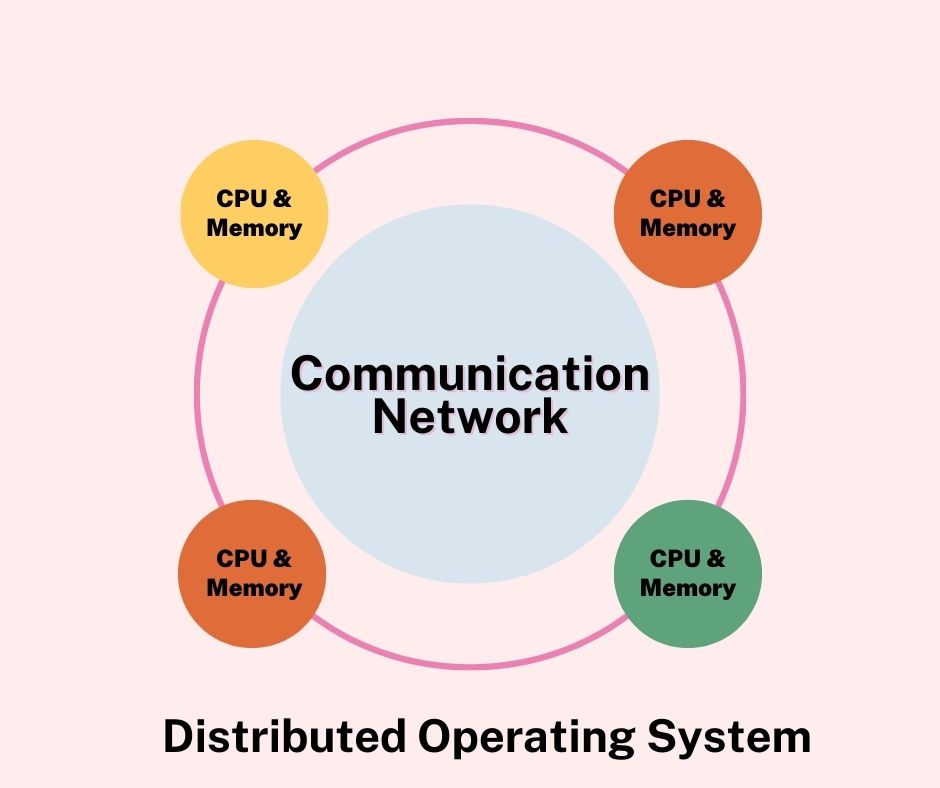
Examples of Distributed Operating Systems:
Apache Hadoop, Kubernetes, Windows Server, etc.
Advantages of Distributed Operating System :
As all systems are self-contained, a breakdown in one has no bearing on network connectivity in the others.
Data exchange is sped up with electronic mail.
Computation is highly fast and long-lasting since resources are shared.
The host machine's load is lowered.
They allow for the addition of other systems to the network, these systems are easily extendable.
The majority of distributed systems are composed of multiple nodes that work together to provide fault tolerance. Even
if one machine malfunctions, the system still functions.
The amount of time it takes to process data is reduced.
Disadvantages of Distributed Operating System :
The entire communication system will come to a standstill if the primary network fails.
The language used to create distributed systems isn't clearly defined yet.
These systems are not generally available due to their high cost.
Compiling, analyzing, displaying, and keeping track of hardware utilization metrics for large clusters may be quite challenging.
Comparing a DOS-connected database to a single-user system, the latter is easier to maintain and less complex.
Not only that, but the underlying program is incredibly complex and difficult to comprehend.
💡 Prepare: Linux Interview Questions
💡 Also, know about Networking Interview Questions
Embedded Operating System
Embedded operating systems are computer operating systems created specifically for embedded computers.
They're designed to work on machines with limited autonomy (e.g. PDAs). They are designed to be small and efficient, and they can run with a little number
of resources. Embedded operating systems include Microsoft Windows CE and Minix 3.
The below image shows how a Embedded operating system works. An Embedded Operating System is a type of operating system that is built to accomplish a specific purpose for a device that isn't a computer.
Elevator software, for example, is solely dedicated to the operation of elevators and nothing else. As a result, this might be considered an Embedded
Operating System. The Embedded Operating System gives device hardware access to the software that runs on top of it.

Examples of Embedded Operating Systems:
Windows Mobile/CE (handheld Personal Data Assistants), Symbian (cell phones), Linux-based OSes, etc.
Advantages of Embedded Operating System :
It is quick because it is focused to a certain task.
The cost is low.
Memory and other resources are used less in these.
Disadvantages of Embedded Operating System :
Only one job can be done at a time.
It's either tough to upgrade or isn't scalable at all.
Real-time Operating System
Real-time operating systems are utilized while handling data that is updated in real-time. So, as soon as the data is received, the procedure should be completed
and there should be no dealy, i.e. no buffer waits. Real-time OS is a time-sharing system based on the clock interrupt concept.
So, whenever you need to process a big number of requests in a short amount of time, Real-time Operating System is the way to go.
The below image shows how a Real-time operating system works. Imagine a car that has an RTOS-controlled braking system. When the driver presses the brake pedal, the RTOS receives an event. The RTOS then selects the highest
priority task that is ready to run, which is likely the task that controls the brakes. The RTOS then switches to the brake control task and allows it to run. The
brake control task then calculates how much brake force to apply and sends signals to the brake actuators. The RTOS continues to switch between tasks until the
car has stopped.
There are two different types of real-time operating systems:
Hard Real-Time Systems (HRTS): These operating systems are designed for applications where time constraints are extremely tight and even the smallest delay is
unacceptable. These systems, such as automated parachutes or airbags, are designed to save lives in the case of an accident and must be ready immediately.
Soft Real-Time Systems: These operating systems are designed for applications with a less stringent time constraint.

Examples of Real-time Operating Systems:
Scientific experiments, ATC System, FreeRTOS, VxWorks, QNX, etc.
Advantages of Real-time Operating System :
Maximum Consumption: Maximum device and system use, resulting in more output from all resources.
Job Changing: In these systems, the time allotted for task shifting is relatively limited.
Shifting from one task to another, for example, takes around 10 microseconds in older systems and 3 microseconds in newer systems.
Focus on the Application: Give priority to applications that are currently executing, rather than those that are in the queue.
In an embedded system, a real-time operating system is used:
Programs are tiny, RTOS can be employed in embedded systems such as transportation and other applications.
Error-free: These systems are free of errors.
Memory Allocation: Memory allocation is best handled in these types of systems.
Disadvantages of Real-time Operating System :
Limited Tasks: To avoid issues, just a few tasks run at once, and their focus is restricted to a few applications.
Use a lot of system resources: System resources aren't always the best, and they're also pricey.
Complex Algorithms: The algorithms are incredibly difficult to write and understand.
Signals from the device driver and interrupt signals: To respond to interruptions as quickly as possible, it requires appropriate device drivers and interrupt signals.
Thread Priority: As these systems aren't prone to changing duties, setting thread priority isn't a good idea.
Network Operating System
Network operating systems are deployed on servers, allowing users to manage data, user groups, and other resources.
Data, users, groups, security, applications, and other networking operations are all managed by these server-based systems.
These operating systems provide shared access to files, printers, security, programmes, and other networking features via a small private network.
Another essential feature of Network Operating Systems is that all users are aware of the underlying configuration, as well as the identities of all
other users on the network. These computers are referred to as tightly connected systems because they have many separate connections and so on.
Network operating systems are used in networks with two kind of nodes: Servers and Clients.
The below image shows how a Network operating system works. The server is the central computer in the network. It is responsible for storing and sharing files, managing printers, and providing security to the network. The
clients are the computers in the network that access the resources provided by the server. The network is the communication channel that connects the server
and clients.
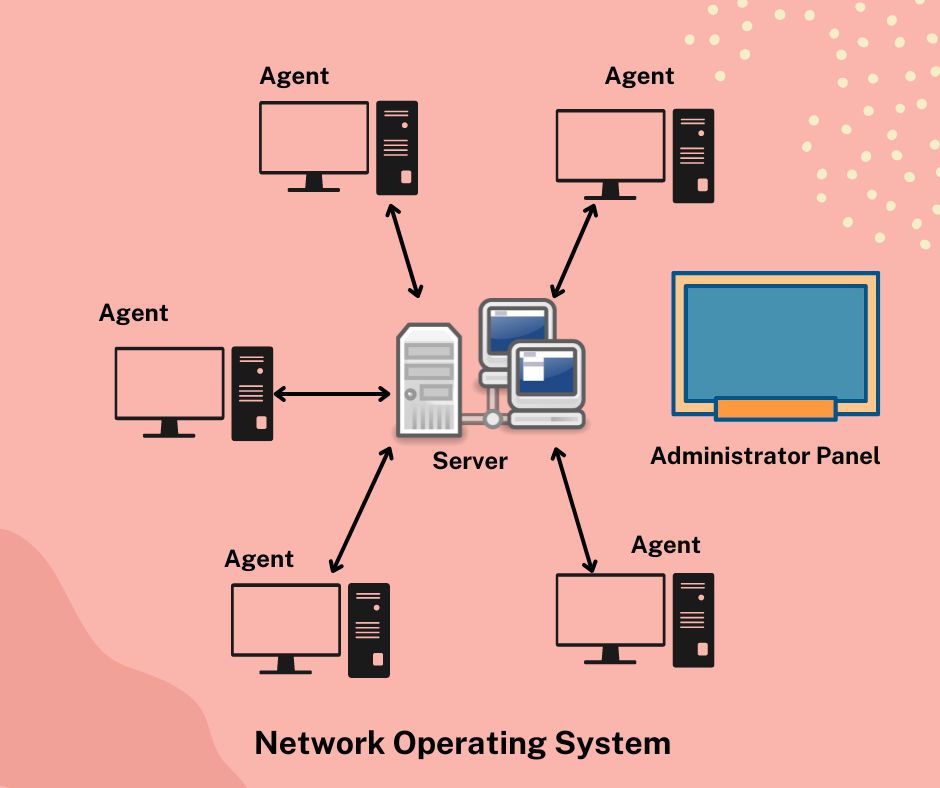
Examples of Network Operating System:
Microsoft Windows Server 2003, Microsoft Windows Server 2008, UNIX, etc.
Advantages of Network Operating System :
Centralized servers that are extremely stable.
Servers are used to address security concerns.
New technologies and hardware improvements are easily accommodated by the system.
Access to the server can be done from a variety of locations and platforms.
Disadvantages of Network Operating System :
Servers are expensive.
The user must rely on a central location for the majority of procedures.
Regular maintenance and updates are required.
Multiprogramming Operating System
Multiprogramming is a type of batch processing in which the CPU is constantly busy. CPU time and IO time are two types of system time that each process requires.
There are numerous programs that need to be executed. As a result, these programs are held in the ready queue. And are assigned one by one to the CPU.
If one process is blocked, the CPU is assigned to other processes in the ready queue. The goal is to maximize resource use and CPU utilization.
In a multiprogramming environment, after a process completes its I/O, the CPU can move on to the execution of other processes. As a result, multiprogramming
increases the efficiency of the system.
The below image shows how a Multiprogramming operating system works. The CPU is the central processing unit of the computer. It is responsible for executing the instructions of the programs that are running. Memory is the computer's
storage for programs and data. The multiprogramming operating system is responsible for managing the CPU and memory and for switching between programs.
The programs are the applications that are running on the computer.

Examples of Multiprogramming Operating System:
Apps like office, chrome, Windows OS
Advantages of Multiprogramming Operating System :
It increased throughout the system since the CPU was continually running one program.
It's also possible to cut response times in half.
It improves CPU use and never sits idle.
The resources are used wisely.
Short-term occupations are completed faster than long-term jobs.
Disadvantages of Multiprogramming Operating System :
Multiprogramming systems create an environment in which multiple system resources are efficiently utilised, but they do not allow
for any user interaction with the computer.
The more difficult challenge is managing all processes and tasks.
Long-term jobs will demand a long wait if it has a high number of jobs.
CPU scheduling is necessary.
💡 Learn about OSI model
Multiprocessing Operating System
A multiprocessor operating system is one that makes use of numerous processors to boost performance. This operating system is frequently encountered on machines with multiple CPUs.
The system contains numerous processors, each of which can handle multiple tasks at once.
Parallel computing is performed by multiprocessing. The presence of numerous processors in the system allows it to conduct multiple operations at once,
resulting in higher throughput.
The primary goal of employing a multiprocessor OS is to consume a large amount of computing resources while increasing the system's execution speed.
The below image shows how a Multiprocessing operating system works. Nodes are the individual computers that are part of the distributed operating system. The network is the communication channel that connects the nodes together.
The distributed operating system is responsible for managing the nodes and resources of the distributed system. Users are the people who are using the distributed
system.

Advantages of Multiprocessing Operating System :
Multiprocessing technology allows processing tasks to be distributed across multiple processors, increasing reliability.
The job can be transferred on to another processor if one fails, the system is more reliable.
Increased in number of processors: As the number of processors grows, more work can be accomplished in less time.
Advantageous for jobs that demand complete utilization of the processor, such financial simulations, scientific computations, and gaming.
Disadvantages of Multiprocessing Operating System :
A multiprocessing operating system is more complex and advanced since it manages multiple CPUs at the same time.
They necessitate additional hardware, like as processors and memory, which raises the cost of a system.
It has significant hurdles due to skew and determinism.
It requires context switching, which can have an impact on its performance.
Mobile Operating System
An operating system that facilitates the use of application software on mobile devices is known as a Mobile operating system. The software is similar to that
of the well-known computer operating systems Windows and Linux, but it is somewhat lighter and simpler. Smartphones can run a variety of operating systems,
including Android, Maemo, Windows Mobile, BlackBerryOS, iOS, and Palm WebOS.
The system incorporates extra features suitable for a portable device along with the functionality of a personal computer. When a mobile device is turned on, its
operating system launches in order to make installed apps accessible. Wireless network connectivity is also managed by mobile operating systems.
The below image shows a Mobile operating system, a simple yet effective representation of the four major mobile operating systems: Android, iOS, Windows,
and Blackberry. These operating systems are the software platforms on which all mobile applications run. Each of these operating systems has its own strengths
and supply to different user needs and preferences.
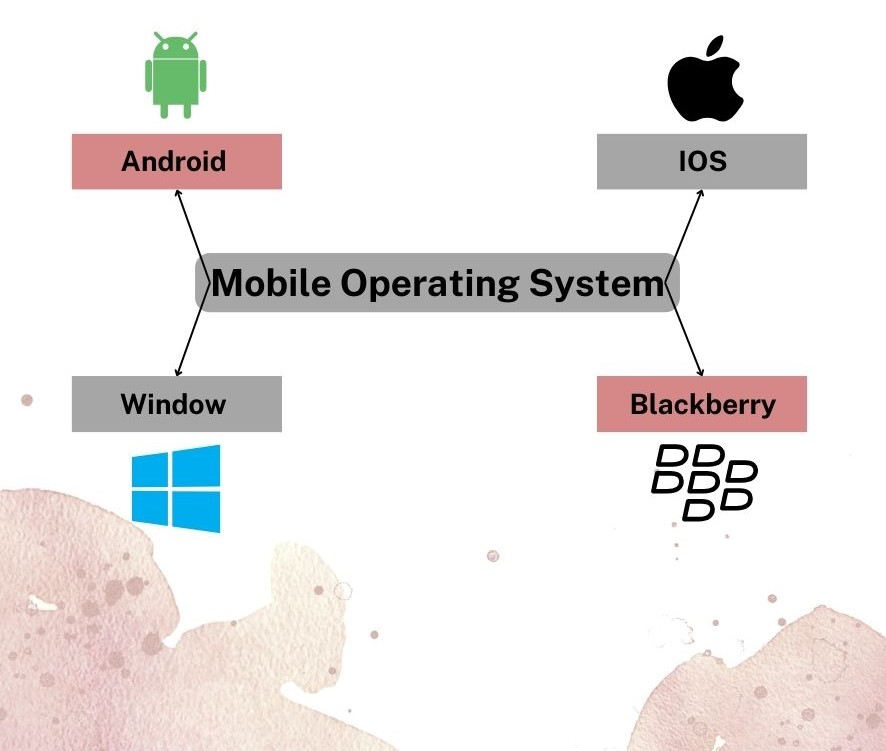
Examples of Mobile Operating System:
Android, iOS, Windows Phone
Advantages of Mobile Operating System :
Most systems are simple for users to become familiar with and use.
It also consists of open-source software.
Disadvantages of Mobile Operating System :
Certain mobile operating systems severely deplete a device's battery, necessitating frequent recharging.
Certain systems lack user-friendliness.
Functions of an Operating System
An operating system (OS) is a vital software component that serves as an intermediary between a computer's hardware and its users. It performs various
functions to ensure smooth and efficient operation of the computer system.
Three fundamental functions are provided by an operating system: it exposes system hardware resources to programs, usually via a defined API; it initiates and
controls application execution; and it provides a user interface (UI) via a command line interface (CLI) or graphical user interface (GUI).
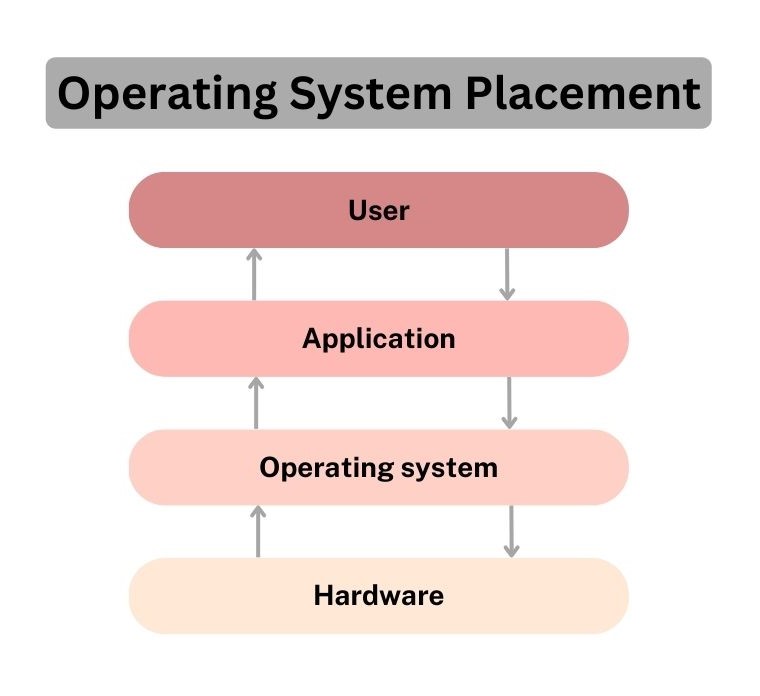
Here are the key functions of an operating system:
Process Management: The OS manages processes, allowing multiple applications to run concurrently. It handles process scheduling, execution, and termination.
Memory Management: It allocates and deallocates memory for processes and ensures efficient utilization of RAM, virtual memory, and other storage resources.
File System Management: The OS provides file and directory management, enabling users to create, access, and organize data stored on various storage devices.
Device Management: It controls hardware devices, facilitating communication between software and peripherals such as printers, keyboards, and storage devices.
User Interface: The OS offers a user-friendly interface, including command-line interfaces or graphical user interfaces (GUIs), for user interaction.
Security and Access Control: It enforces security policies, user access permissions, and data protection measures to safeguard the system and its resources.
Networking: Many modern OS's support network functionality, allowing devices to connect and communicate over networks.
64-bit vs. 32-bit Operating Systems
| Aspect |
64-bit OS |
32-bit OS |
| Processor Capabilities |
64-bit processors are more capable as they can handle larger data sets and computations. |
32-bit processors have limitations in handling data and memory. |
| Memory Addressing |
64-bit processors can access over 4 billion times the physical memory of a 32-bit processor. |
32-bit processors have a limited memory addressing capacity, typically up to 4GB. |
| Performance |
64-bit processors can perform more computations per second, resulting in faster task completion. |
32-bit processors are slower due to their lower computational capacity. |
| Supported Operating Systems (2023) |
Commonly supported by modern OSs like Windows 10, Windows 11, Linux distributions, and macOS. |
Still compatible with older systems, but may not fully utilize newer 64-bit OS features. |
💡 Also read, Difference between Compiler and Interpreter
Conclusions
Operating systems are the essential software that powers our computers and mobile devices. They are the bridge between us and the machines
we use to work, play, and connect with the world.
With so many different types of operating systems available, it is important to choose the one that is right for your specific needs. Consider
factors such as the type of device you are using, the tasks you need to perform, and your personal preferences.
As the world becomes increasingly digital, operating systems will continue to play a vital role in our lives. The future of operating systems
is bright, and we can expect to see even more innovative and powerful operating systems emerge in the years to come.
Good luck and happy learning!
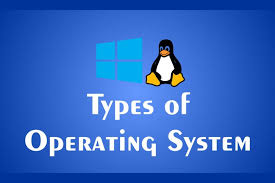

 Logicmojo
Logicmojo 